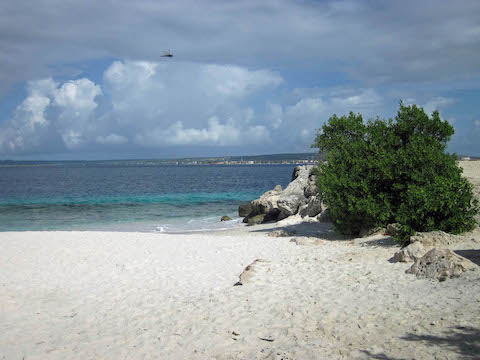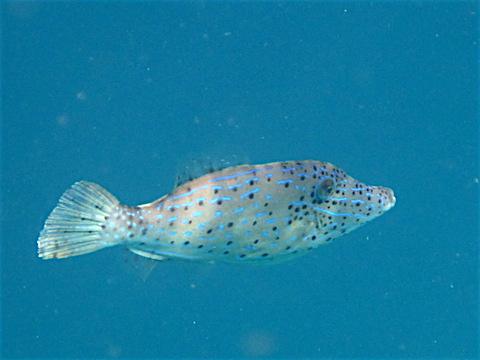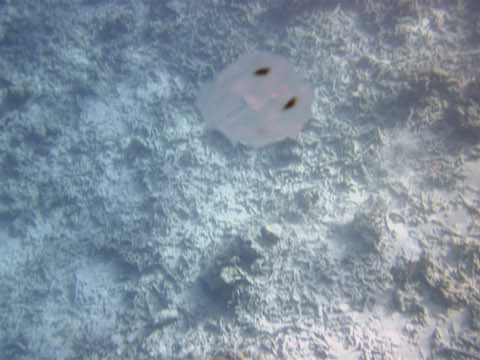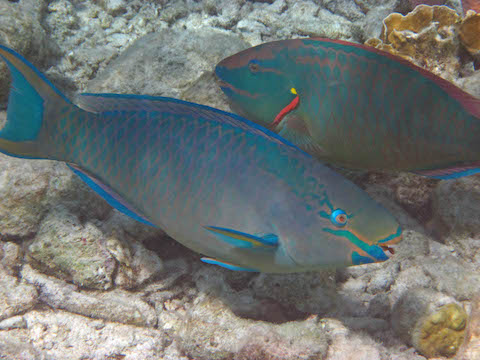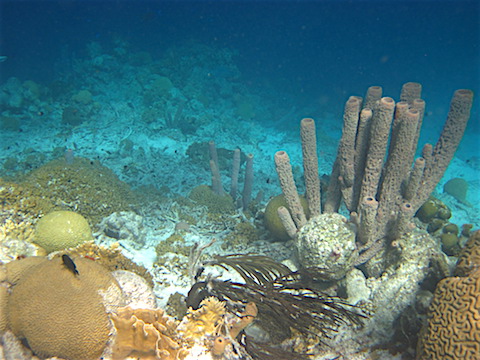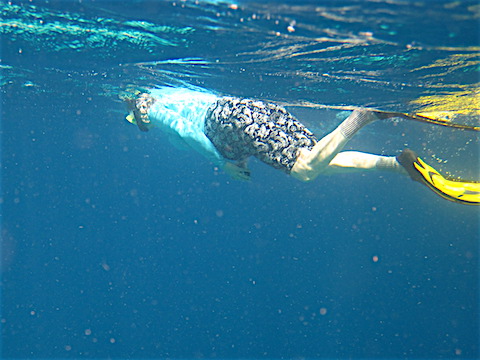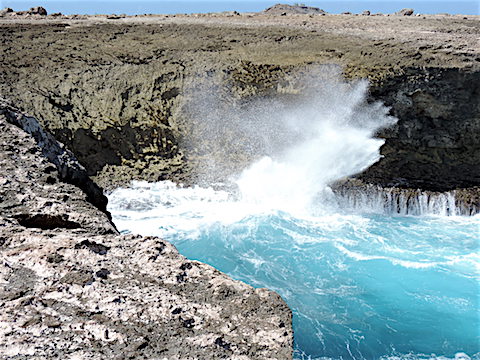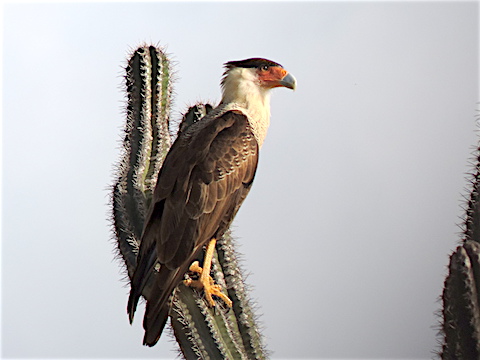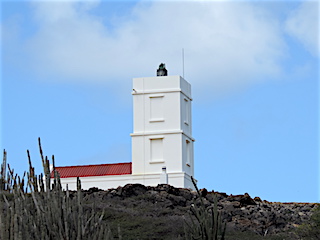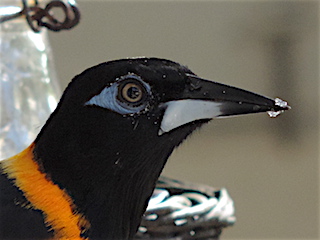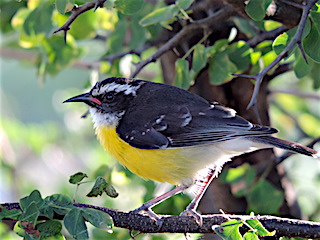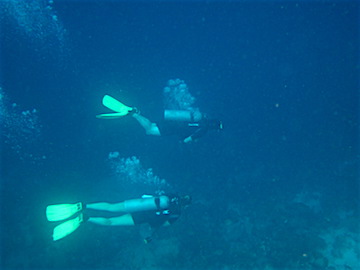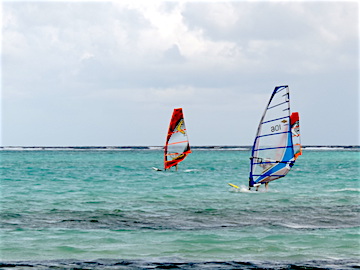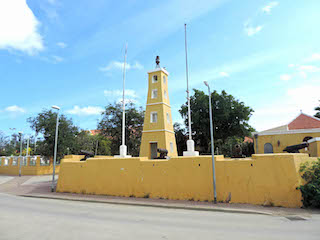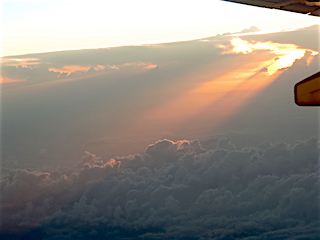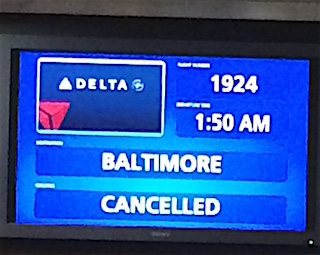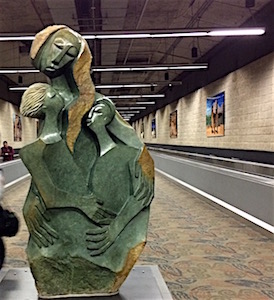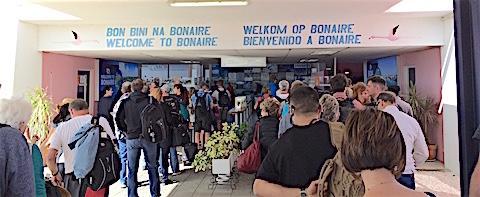
This winter, our sun & snorkel escape was to Bonaire.
Bonaire is a small Dutch island
off the coast of Venezuela, 117 miles east of Aruba,
where we vacationed last winter.
Our visit was just a short Sunday-to-Sunday visit, January 15 to January 22,
in part because
there are direct flights to and from the U.S. only on weekends.
We snorkeled, visited Washington-Slagbaai National Park, looked for birds,
and kayaked and snorkeled in a mangrove forest.
At 12 degrees north, Bonaire is close to the equator. At night Orion was
nearly directly overhead and the bright southern star Canopus could be seen above
the southern horizon.
|
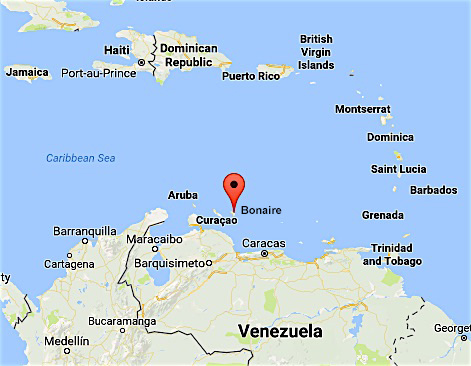
|
Snorkeling
|
Bonaire's license plates feature the slogan “Divers Paradise”.
The entire coastline is a marine sanctuary.
And the drop off typically starts only a few dozen meters from the shore,
making it easy for divers to reach the depths without needing a boat.
That is not so good for snorkelers, however, because there is less
territory that is shallow enough for them. Furthermore, there was
a hurricane some years ago that destroyed a lot of coral and not
all of it has grown back. Nonetheless, we had a good time.
We snorkeled at four locations: Buddy’s Reef (located at Buddy’s Dive Resort),
Windsock (at the end of the airport runway), Klein Bonaire (a small island
sheltered by the main island), and 1000 Steps (north of Kralendijk, the main town).
Buddy’s Reef was easy to get to because we just walked onto the dock at
the resort, past the customers, and down stairs into the water.
However, our snorkeling was disappointing.
In the shallow region there was little in the way of coral.
Much of the bottom was covered with silt. And
the fish were mostly small. Furthermore, my waterproof Canon D10 camera was acting up,
claiming that my battery did not have a charge, so I did not get any photos.
However, one interesting thing we saw was small trumpetfish swimming very close
to the back of a larger fish, almost as if it was glued there.
Was this behavior something called “nuclear hunting” where the trumpetfish
was hoping that the other fish would scare something up from the bottom
that the trumpetfish could eat?
We saw this behavior again at 1000 Steps.
|
Coming up in a rain shower

|
Windsock was better. In addition to some of our old favorites,
such as a sea turtle, trumpetfish, parrotfish, and others,
we saw a Scorpionfish near the drop off. That was new to us.
We took the water taxi to Klein Bonaire and dropped off our dry-land gear at
No Name Beach. Then the captain of the taxi took us east and dropped us off in
the water so we could snorkel back to the pickup spot.
This was also pretty good snorkeling, except most of the way back to
No Name Beach we were swimming through jellyfish, ranging from
the size of pencil erasers to that of a fist. They stung us several times,
but the sensation quickly went away.
We also encountered trash. We plucked
several plastic bags and parts of plastic bags out of the water.
The nice part about the No Name Beach was that it had sand! We did not
have much time to enjoy it though. We finished our snorkel trip just as the
water taxi was pulling up for our return to the main island.
On Friday, we drove up the shore to the
1000 Steps dive site.
This location, bounded by cliffs, is very picturesque.
The beach is covered with coral rubble, as are most of the
beaches on Bonaire.
There was significant amount of coral near the shore.
We saw turtles, porcupinefish, trumpetfish, and many other varieties.
A highlight was a tarpon, the largest fish we’ve seen since the
sharks we saw at St. John, USVI.
I did not get any photos here because my camera
died as soon as I got into the water. Water came into
the battery compartment. The camera had worked well since
it had been repaired after our
2012 visit to St. John,
so I guess it is time for a replacement.
The 1000 Steps (actually about 70) down to the shore
|
The beach at 1000 Steps. You can see why Bonaire is not
a great draw for bodies that just like to sun on the sand.
|
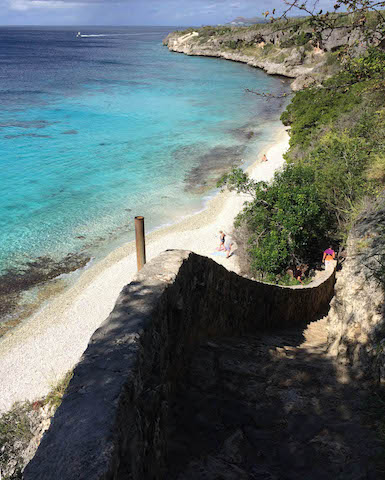
|
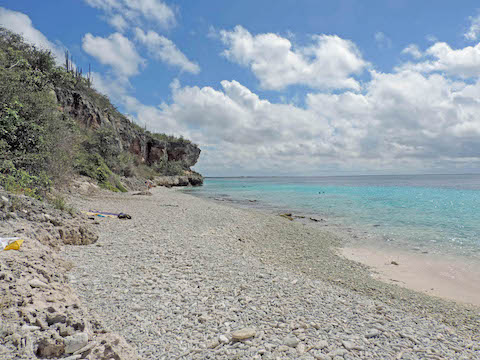
|
Living on Bonaire
|
We stayed in a small privately-owned
studio apartment
in the Belnem district
just south of the airport. The kitchen facilities were small - a two-burner
stove and a half-sized refrigerator - and the dining table was outside,
but that was OK because we wanted to
taste the food of the island for our main meal.
There was a jaccuzi in the yard and a flower garden that attracted lots
of birds. Our hosts, Jolanda and Jaris, and their daughter, Wilhelmina,
were very friendly and cheerful.
We sampled several restaurants: Karel’s Beach Bar, Cuba Compagnie,
Tasty Bar & Steakhouse, El Mondo, Rose Inn, and E Teras.
All except Rose Inn were in Kralendijk.
Rose Inn in Rincón was recommended by the Dutch tourists who lived in the studio
next to ours. E Teras was just a little neighborhood restaurant on
Kaya Nikiboko Zuid, just south of the Catholic church.
I really liked the garlic soup at Cuba Compagnie, the fish soup at
Tasty Bar & Steakhouse, and the goat stew and the chicken stew
at E Teras.
We had Lionfish soup at El Mondo, doing our part to control this
invasive species in the Caribbean. Dare I say
we were putting our mouths where our hearts are?
Anyway, the Lionfish flesh was very tender.
To get around on the island, we rented a small Daihatsu Terios SUV.
We chose a rugged vehicle so we could drive in the National Park.
|
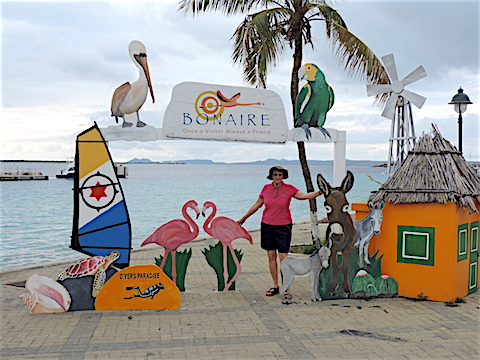
|
Our dwelling
|
Enjoying the sunset with a bottle of Amstel Bright
at Karel’s Beach Bar.
|

|

|
Birding
Bonaire is close to Aruba so most of the bird species we saw here
were ones we had seen last year.
Our rental unit had a beautiful flower garden. We could sit
in the yard and watch Bananaquits, Blue-tailed Emerald Hummingbirds,
Venezuelan Troupials, and Ruby-topaz Hummingbirds fly in to feed.
It did not hurt that Jolanda put out sugar water to feed them too.
Occasionally Tropical Mockingbirds,
White-tipped Doves, and Brown-throated Parakeets would drop in.
Frequently Bare-eyed Pigeons would perch on nearby streetlights
and roof ridges.
The signature birds of Bonaire are American Flamingoes!
We saw them at many locations. They were along EEG Boulevard on the
southeast coast. A flock of several hundred were in the wildlife refuge
near Lac Bay, but they were far from the road and access was prohibited.
Others were in the salty lakes in the national park.
We saw several Crested Caracaras in the national park and one near Lac Bay.
There was a flock of dozens of Yellow-shouldered Parrots on cacti and
trees along the road from Rincón to Kralendijk.
A Flamingo along EEG Boulevard
|
One of the Yellow-shouldered Parrots
|

|

|
A pair of Brown-throated Parakeets in Jolanda’s garden
|
A Ruby-topaz Hummingbird in Jolanda’s garden
|
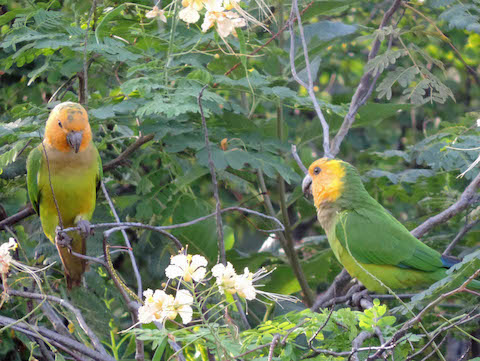
|

|
Washington-Slagbaai National Park
The south half of Bonaire is flat, but the northern tip consists of rocky hills,
the highest of which reaches 784 feet, and that is where the National Park is located.
The park has picturesque locations along the shore, saltwater lakes where flamingos feed,
a lighthouse, and some diving sites,
one of which is Boca Slagbaai, a nice beach with historic buildings
and the only restrooms inside the park.
There is basically one one-way road that circles the park, though there is a
cut-off for visitors who want to skip the northern shoreline and go
directly to
the highest peak, called Subi Brandaris, or to some of the diving sites.
The roads are formed of rocks, some dirt, ridges of rock running across, ruts,
and washed out gullies.
There are no speed limits because the roughness kept you from going
more than 10 to 20 km/hour.
We visited the park twice, both times in the afternoon.
The first time we ate our lunch on a terrace at the visitor center.
Soon we were surrounded by lizards who were interested in sharing our meal.
Gail drew the line when one of them began to crawl up her leg.
Both times we visited the park, we stopped at locations said by the park brochure to be
great bird watching, but it was the middle of the afternoon and all we saw were
a couple flycatchers and yellow warblers.
At Boka Kokolishi we found trash washed up on the beach. We took out
five 4-gallon bags worth, but left a lot of small fragments of styrofoam.
It is said that most of Bonaire’s coastal litter floats in
from the rivers of South America
where they don't have adequate environmental policies.
Other Memories
|
One highlight of our visit where we did not get any photos was
a kayak and snorkel tour of a mangrove forest at Lac Cai.
Lucky Luke, our naturalist, led us through narrow channels among the red
mangrove trees and told us about the mangrove and its ecology.
We slipped from our kayaks for a
short snorkel through another channel where orange and purple
sponges covered the mangrove roots, where jellyfish
lay upside down on the bottom, and where young fish swam.
Our adventure was diminished only by the two of us being the
only tourists who needed help to get back into the kayak
after our snorkel and by there being a lot of mosquitoes in the mangroves.
Twice we got glimpses of flying fish, once while seating at Karel’s Beach Bar
and once on the water taxi to Klein Bonaire. Wow!
Our afternoon flight from Bonaire to Atlanta was uneventful, but in Atlanta
our flight to Baltimore kept being delayed because severe storms
prevented the crews from getting to Atlanta.
Eventually the flight to Baltimore was cancelled at 2:20 AM.
Delta gave us a voucher for a nearby hotel, and we got to bed
at 4 AM.
Delta's computers figured out a route to get us to Baltimore the next day:
from Atlanta to Akron, from Akron to Detroit, and finally from Detroit
to Baltimore.
When we showed up at the gate for the flight to Akron, the gate agent told
us that the route was ridiculous and she quickly found us a direct flight
to Baltimore leaving an hour later. That worked well and our checked bag even got
there with us.
A triumph of human intelligence over computer!
If we had not been stuck in Atlanta, we would have missed a nice
exhibit of stone sculptures from Zimbabwean artists in the walkway
between the terminal and concourse A.
|
This is not my photo.
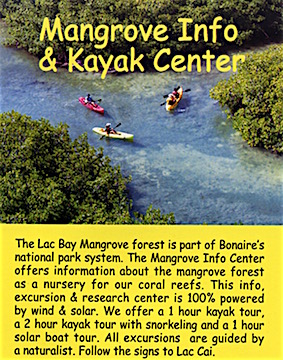
|
Responsible: Albert Holm
Created: 30 January 2017; Updated: 10 January 2019



